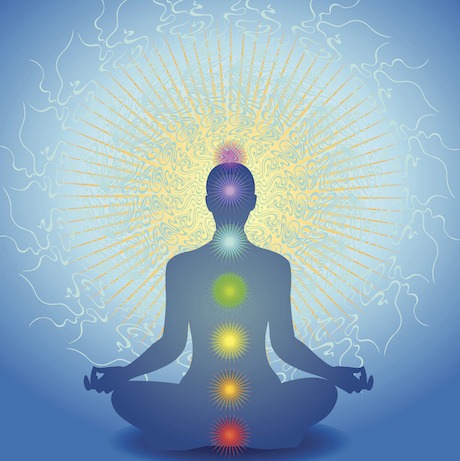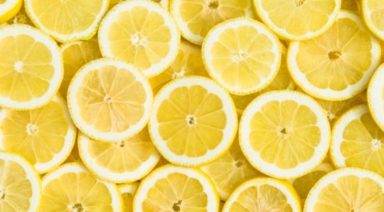Chakras: What They Don’t Tell You at Yoga Class

Six blind men lived in a village. One day a villager said, “Wow, there’s an elephant here today!” The blind men had never experienced “elephant.” After conferring, they decided to go touch the elephant and find out what the excitement was about. They gathered around the beast and each took hold of a different part.
The blind man holding the elephant’s leg said, “Hey, this elephant is like a pillar.”
Another, holding the tail, said, “No no! It’s like a rope.”
The third, touching the elephant’s trunk, said, “You’re both wrong — the elephant is like a thick tree branch.”
Another, holding the elephant’s ear, said, “It’s like a big banana leaf.”
“No. It’s like a huge wall,” said the blind man touching the elephant’s side. At this point one can only wonder at the patience of this elephant.

The sixth blind man said, “You’re all wrong. An elephant is like a solid pipe.” He was touching the elephant’s tusk, perhaps just prior to the elephant using it to toss the him over its shoulder.
Aside from the ensuing arguments about who was “right,” each blind man was correct in his perception — there was truth in each experience. In the Jain tradition, it is said the truth can be stated in seven versions or points of view, and the lesson is to be tolerant of the experiences and perceptions of others.
Thus it is with chakras. We’re like blind men with an elephant — each with our own view of the chakra system based on experience, exposure, what we’ve seen, read, heard, or been told — but ironically, it is the cherished belief in our “rightness” (about virtually anything) that ultimately blocks the development and unfolding of the subtle body’s energy centers. Defending any position can launch us into a state of emotional reactivity — the kryptonite of spiritual evolution.
“In different traditions, one can find wheels, flowers, angels, animals, animal parts, geometric shapes, children, the seven dwarves, deities, buddhas, yantras, or mandalas. But in fact, across the board, believing in any judgements which give rise to emotional reactivity is the one sure way to ‘block’ the performance of a chakra,” said Lar C. Short, author of The Way of Radiance and co-author of The Body of Light. By referring to the “performance” of a chakra, Short distinguishes these centers as activities (verbs) rather than things (nouns).
So gentle seeker, or finder as the case may be, suspend disbelief for this exploration of the paradoxical human chakra energetic system.
Dormant chakras are energetic potentials in the same way a bud is the possibility of a flower, or an acorn is a potential oak tree. A flower’s bloom may be waning, having served its purpose of attracting pollinators, but the flower is still developing its full potential. If left undisturbed, the flower’s next stage is ripening to a seed pod or fruit.
This is the true completion of “flower,” and can be considered the “absolute” stage, a naked state of the essence of flower. As with the flower, a dormant chakra, given the correct care and nourishment, matures and blooms — but the absolute open, complete state of creative potential is the disappearance of the “bloom,” leaving only free-flowing nadis and fields of energy.
What is Tantra?
“When an action or a thing, once complete, becomes beneficial in several matters to one person, or to many people, that is known as Tantra.”
~ Sabara, 6th Cent. A.D.
To understand this multitude of chakra systems, we must understand Tantra — a woefully misunderstood word. Google “what is tantra?’ and most results will refer to “tantric sex,” which was a minimal part of ancient Tantric doctrine and teachings.
Tantra originally referred to mystical or ritual texts based on the premise that all realities are the product of the creative dance of the divine mother, Shakti — the primal power or energy of all existence — and Shiva, the great singular consciousness, or “godhead.” The texts often took the form of conversations between Shiva and Shakti, which generates the totality of the universe. Tantric traditions embrace the elements — generally earth, water, fire, air, and ether — as the primary raw materials of material existence; the “legos” of reality.
The original Tantra tradition in this chapter of human history was Kashmiri Shaivism, predating the early sources of contemporary postural asana yoga practices. This system emerged and flourished from around 600 to 1,300 A.D. For context, hatha yoga appeared around 1,100 A.D.
At its peak, Shaivism, originating in the Kashmir Valley (bordered by the Himalayas and the Pir Panjal mountain range), was widespread throughout India, Nepal, Pakistan, Southeast Asia, and Indonesia. Shaivism informed and influenced Tantric Buddhist, Taoist, Shingon, Hindu, and shamanic esoteric systems. The tradition is traceable to even earlier Vedic writings dating the late Bronze/early Iron Age.
Now somewhat obscure, Kashmiri Shaivism teachings fall under the umbrella of what we call Hinduism, but their influence is clear in Tibetan Vajrayana Buddhist methods, the most visible surviving Tantric tradition today.
But what is the essence of Tantra? “Tantra is fundamentally world-embracing rather than world-denying, focused on the immanent rather than the transcendent, integrated with everyday life rather than renouncing it,” says Christopher Wallis, Sanskrit scholar and Tantric teacher.
Wallis goes on to define the “transcendentalist” view, that the divine is out of the reach of our normal senses and may only be contacted through higher states of consciousness. In contrast, the Tantric view is that the world, and everything in it, is the expression of the divine, and seeking a deeper awareness of all leads to realization.
What is the Subtle Body?
“Our biological body itself is a form of hardware that needs reprogramming through tantra like a new spiritual software which can release or unblock its potential.”
~ Slavoj Zizek, author, “Living in the End Times”
Everyone has a subtle body — it is the subtle body that perceives sensation and is experienced by amputees when they feel phantom pain in missing limbs. The subtle body is also the astral and dream-state vehicle. Tantric systems, such as Taoism, Japanese Shingon, and Tibetan Buddhism, view the subtle body as a vibrationally refined aspect of the physical body, central to spiritual evolution.
“The energetic body constitutes a vital link in the attainment of higher inner development. It is a system for creating higher energies through a form of inner alchemy,” say the authors of “Body of Light.”
Closely held cultivation practices, including meditation, internal energy yogas, visualization, mantra, and puja, have passed across centuries, sometimes as “ear whispered” transmissions. The early tantrikas established secrecy to protect the teachings from corrupt or inaccurate transmission, and to be sure, they were not passed to practitioners not yet ready for the experience.
Non-tantric traditions, i.e. Zen Buddhism, see the subtle body as secondary, and instead endeavor to confound logic so higher forms of understanding become accessible — think of a zen koan, like “When you can do nothing, what can you do?”
In her Lion’s Roar review of “Religion and the Subtle Body in Asia and the West,” Lama Willa Miller writes, “In contemporary Tibetan Buddhist practice, the subtle body acts as a kind of bridge between the body and mind. This view can be found dating back to the work of Yangonpa Gyaltsen Pal (1213–1258), a Tibetan yogi and author of one of the earliest Tibetan handbooks describing the subtle body.”
Miller references Pal’s text, “Description of the Hidden Vajra [subtle] Body,” which explains the subtle body can be “reconditioned” with focus, training, and intent; even permanently altered to support a more enlightened state of being. When a practitioner achieves the independent subtle body, their consciousness is no longer dependent on his physical form.
When an accomplished tantrika with an independent subtle body enters the stages of death, it is that subtle body that is perceived as the rainbow body. With this evolved energy body, rather than entering the bardo (the in-between state between death and rebirth) at the time of physical death, highly advanced adepts can consciously depart the great illusory wheel of samsara — the unending karmic cycle of time, birth, death, and rebirth.
How do the Chakras and the Subtle Body Work Together?
“In the view of Tantra, the body’s vital energies are the vehicles of the mind. When the vital energies are pure and subtle, one’s state of mind will be accordingly affected. By transforming these bodily energies we transform the state of consciousness.”
~ The 14th Dalai Lama
“Body of Light” co-author Lar Short explains, “Chakras are points where the energy of the subtle body can pool or become blocked, similar to kinks in a hose. Chakras have different frequencies of vibration, and some act similarly to organs in the physical body; others are like nerve plexus points. When the subtle body is fully open and developed, the chakras cease to exist. Then there are only the free-flowing nadis and fields of energy.”
The subtle body is the context of the chakra system just as the physical body is the context for organs and the circulatory system. Fully opened chakras disappear like knots removed from a length of silk thread — a paradox in the beginning, but congruent with the chakra as a verb rather than a noun — a concentrated, energetic activity rather than a luminous colored frisbee. At this point, the systems, channels, and points operate as an integrated, conscious energy field.
Shiva and Shakti’s Cosmic Romance
“The universal eons consist of two branches, without beginning or end, which spring from one root — the invisible power and the unknowable silence.”
~ Gnostic Mystic Simon the Magus
Shiva was the original “one,” according to Tantric myth. He existed in a dream state of formless, infinite consciousness. But as the great singularity, he was lonely, and without living form he was simply the eternal dreamer, unable to turn vision into substance. Shiva was incomplete.
He dreamed up Shakti, the wild, divine feminine energy with the power and potency to give form and life to Shiva and his visions. If he joined with Shakti, her creative power would manifest his visions — even his vision of himself. But she had to agree — he couldn’t force her to cooperate. He pitched the idea to the radically uncontained Shakti.
She listened, and understood that by giving him her immeasurable, life-giving power, she could bring life to Shiva’s dream of a multidimensional cosmos. But she also knew that her energy would be captured in form — utterly contrary to her untamed nature.
“Tell it to the judge,” she said.
Shiva decided to up his game. He showed her visions of what they could create if they joined in cosmic marriage; beings and worlds and things in numbers beyond imagining, unless of course you’re Shiva the dreamer.
“No dice. Don’t fence me in,” she said, unwilling to be domesticated.
But Shiva didn’t give up. Because there was no time, he had all the time in the world to find a way to convince her. He pondered her resistance, then dreamed a new chip to lay on the table. Interrupting her unrestrained performance again, he said;
“Imagine this. Every single thing we create will be distinct from all other things. Every single thing will be utterly unique. And anything our creation produces will be different from all other things. No two things will ever be the same.”
Shakti imagined this as was captivated, inspired by the creative possibilities. And though he was formless, Shiva was starting to look good. She decided it was worth the price of admission to see the show. And she comforted herself with the knowledge that he couldn’t do it without her. It was a hard choice — she almost bolted at the last minute like a runaway bride — but at last she surrendered. And when the two joined, their embrace was so powerful they became one.

Shiva/Shakti commenced the cosmic dance without end, calling forth universes and everything in them; sound and vibration, light and dark, all the elements, oceans and rivers; mountains, gods and goddesses, humans and devas, demons and nagas, animals, fish, birds, celestial events, moons, suns, stars, and worlds.
Within all, from the most to the least, was Shakti’s divine spark and Shiva’s singular consciousness. Because time was a byproduct of creation, there was impermanence, and all that was born would die.
Because the dance was eternal, new worlds and things appeared while others ripened and dispersed. Within and without, betwixt and between, flowed the mysterious materia prima; the mighty gravitational force of love, ever-present and inexhaustible, the deepest essence of their joining. No two things, from galaxies to motes of dust, were the same.
The story is scalable; as above, so below. Just as we are born with a unique DNA blueprint determining our physicality, so do we carry a singular blueprint of our spiritual potential. The dormant seed of an independent subtle body carries the possibility of qualities and expression unlike any other because of Shiva’s promise to Shakti.
So, in the spirit of entertaining paradox, meeting on similarities, and learning from differences, let’s explore chakras.
The Seven Muladhara Chakras
“When we develop the heart chakra, we begin to influence our surroundings with our spiritual presence. When we develop the communication chakra, we begin to influence the country with our spiritual presence. When we develop the seventh chakra, without doing anything at all, we begin to influence the world with our spiritual presence.”
~ Swami Dhyan Giten
We’re accustomed to seeing chakras portrayed as a stack of seven spheres, lit up like traffic lights, with the hue progression of a rainbow, but this image has little to do with original Tantra descriptions. Early descriptions of the subtle body and its centers from roughly 200 BCE make no mention of color. Rainbow-colored chakras do not exist in Vedic or Tantric literature, and there is no single, authoritative source regarding chakras systems, symbols, or colors.
The rainbow image first appeared in the the 1970s on the cover of Nuclear Evolution: Discovery of the Rainbow Body, an influential “New Age” text now out of print. In the book, author Christopher Hills explored bioluminescence, auras, chakras, Jung’s archetypes, Einstein’s theories, and “the highest yogic teachings.” Hills enjoyed an eclectic career as a philanthropist, yogi, businessman, Rastafarian advocate, gallery owner, photographer, conference organizer, educator, and globetrotter. Perhaps the most visible aspect of his legacy is the omnipresent rainbow chakra illustrations that now has popular culture acceptance as the final word on chakra systems and imagery.
That said, if working with rainbow colored chakras resonates, and you experience a subtle body response such as tingling in the area, or a sense of pooling energy, carry on. It’s not about being “right” or second guessing yourself — it’s about working with what brings results. It’s also about sensation, the sign of an enlivened subtle body.
The ancients had other ideas, and in their chakra art we find many other things — symbols, creatures, and different colors. Buddhist and Hindu schools state each chakra has a flower with a corresponding number of petals. According to the Body of Light, “In the Hindu tradition, the navel (lower belly) center is associated with fire, the color red, and the syllable ‘Ram.’ In Tibetan Buddhism the navel center is associated with water, the color white, and the syllable ‘Vam.’
“Furthermore, color symbolism in different chakra systems is contradictory. For example, in the Hindu tradition, the chakra colors are, going from bottom to top: red-orange, kelly green, yellow gold, sky blue, and indigo-purple. In the Buddhist system they are, in the same order yellow, white, red, green, and blue. In color therapy and New Age symbolism they are different from the above and also from each other.”

With so many contradictory associations, perhaps it’s best for each tantrika and aspirant to approach the chakras as a personal unexplored territory and glean the truth from their experience with the understanding that their unique discoveries can be a foundation for a personal mythology.
The descriptions below are derived from Vedic and Tibetan Tantric traditions.
- Muladhara: Sanskrit: Mool = root, adhara = support. The root chakra, as it is called, relates to groundedness, the survival instinct and physical plane, and according to the Tibetan tantra, the immune system, legs, feet, and kidneys, and perineum. Vedic and Tibetan tantras assign the muladhara four petals, and relate this chakra to Ganesh and the goddess Shakti. The muladhara element is earth, its bija (seed syllable) is LAM, and this chakra relates to the ancestors — those from whence we came. The associated color is yellow, and the muladhara relates to the physical sense of smell. It is associated with the elephant, as Ganesh is the ruling deity. The Vedics say when the root chakra is fully open, the yogi attains the “darduri siddhi” (power), the ability to rise from the ground, and control of mind and the breath. All sins (karma) are destroyed, and the tantrika gains knowledge of the past, present, and future, and a state of natural bliss. The virtues relate to groundedness and the capacity to feel firmly rooted in existence, skillfully negotiating the phenomenal world. This chakra is the home of dormant kundalini, and location of the of the red “bindu,” or the female essence established at the time of conception. The associated gem and planet are coral and Mars, and the corresponding musical note is C.
- Svadhishthana, the Sanskrit word for the second primary chakra, translates to “one’s own base.” In tantric systems, this chakra is portrayed as a white lotus with six vermillion-colored petals and a crescent moon inside. It is located at the base of the genitals and associated with the water element. Tibetan medicine corresponds this chakra to reproduction and the genitals, and it is also related to basic emotional needs, creativity, joy, and enthusiasm. The gods Brahma and Rakini are related to this chakra, and its bija is VAM. The tantrika who masters this chakra is believed to gain power over the water element, acquire psychic powers, gain control of the senses, and become the “Conqueror of Death.” Virtues include enhanced creativity, the ability to play like a child, and respectfully honoring the body. The crocodile is related to this chakra. The Svadhishthanas’s gemstone is amethyst, and its planet is Mercury. The corresponding musical notes are C# and D.
Note: The upper two chakras are not associated with the elements.
- Manipura translates to mani (gem) and pura, (city) in Sanskrit. This chakra relates to wealth and satisfaction. It is located in the navel. The Manipura is assigned 10 petals and is sometimes portrayed as a red downward-pointing triangle inside of a yellow circle. The associated element is fire, (agni), and the bija is RAM. This chakra is the home of the gods Agni and Lakshmi; the associated powers, or siddhis, are the acquisition of hidden treasure, freedom from disease, and mastery of fire. “Even if he (the yogi) is thrown into the burning fire, he remains alive without fear of death,” says Gheranda Samhita. Tibetans relate the physical solar plexus, spine, spleen, and upper abdomen, gallbladder, small intestines, and adrenal cortex to this chakra. It also governs metabolism and the digestive system. They also associate the Manipura with personal power, fear, anxiety, expansiveness, and growth. Virtues related to a balanced Manipura chakra include self-esteem, a sustained sense of purpose, and a healthy sense of identity. The element is fire, and the corresponding animal is the ram. The gemstone is emerald, and the planet is Jupiter. The corresponding musical notes are D# and E.
Note: Only the four lower chakras are associated with animals.
- Anahata, Sanskrit for “unstruck, or unhurt,” is commonly known as the heart chakra. The anahata has been portrayed with 12 petals of a deep red color containing a hexagon filled with black smoke. It has also been described as a circular flower with 12 green petals, and some systems associate the colors green and pink with this chakra. The anahata has also been described as two intersecting triangles representing the union of male and female, and is considered the residence of the atman, or true self. The bija is YAM. The heart chakra is believed to be the home of the wish-fulfilling tree (Tibetan Tantra), and is also the source of the inner sound (Sanskrit = anahata nada) which is perceived after long practice. This chakra relates to the thymus and circulation, and the associated siddhis are flying, entering the body of another, and cosmic love. The virtues are kindness, compassion, passion, and devotion. The Anahata’s animal is the antelope, the gemstone is ruby, and the planet is Venus. Associated with the air element, the musical notes are F# and F.
Note: These three lower chakras are said to be associated with the material world — our relationships with our physical bodies, creative and reproductive impulses, and values.
- Vishunddha, the throat chakra, translates from Sanskrit to “purification or cleansing.” The associated color is blue, representing the element ether, but the Vishunddha is also portrayed as a silver crescent within a white circle with 16 pale blue or turquoise petals. Associated with the thyroid, the cervical spine, and the voice, the ruling gods are Sadasiva and Shakini. The bija is HAM. This chakra governs communication, independence, and fluent clarity of mind. The Vishunddha plays an important role in dream yoga, or lucid dreaming. The siddhis are success, knowledge of the Vedas, and knowledge of past, present, and future. The virtues are right speech, honesty and good decision-making skills. The gemstone is sapphire, and the planet is Saturn. The musical note is G.
- Anja, which translates to the word “command,” is commonly known as the third-eye chakra. Portrayed with 96 petals, it resides slightly above and between the eyebrows, and the associated gods are Paramasiva and Hakini. It is often portrayed as white, “like the moon.” The bijas are HAM and KSHAM, and the Anja relates to the pineal gland. The opening of the Anja destroys karma of past lives and brings “other benefits that cannot be described in words.” The virtues are the balancing of the higher and lower self and intuitive clarity. He who masters the anja is said to gain the eight major and 32 minor siddhis and liberation while living. The Tibetan system associates the brain and nervous system with the Anja, and the virtues are perspective and wisdom. The gemstone is the diamond, the planet is the Sun, and the musical notes are G# and A.
- Sahasrara which translates to “thousand petaled” in English, is the crown chakra of pure consciousness. It is portrayed with 960, 972, or 1,000 multi-colored petals — or as pure white. It is also described as golden, containing a round moon with a luminous triangle. The bija is OM, or AUM. The Sahasrara is important in Tibetan tantra as the point of conscious projection, or exit of the consciousness, at death. The god Shiva resides here, and when it unites with kundalini, the yogi experiences supreme bliss. The Hindu Tantras say the Sahasrara contains all 50 letters of the Sanskrit alphabet, and Tibetan Tantras identify it as containing the the male white drop, or bindu, which appears at the time of conception. It is associated with the hypothalamus and the crown of the head. The Sahasrara’s gemstone is pearl, and its planet is Pluto. The musical notes are A# and B.
Methods
Some ancient Vedic texts require strange austerity and cleanliness exercises, such as forcing string through the sinuses and out the mouth based on the belief that the body must be purified before the chakras will open. Trying this at home will likely lead to nothing more than nose bleeds. Other more practical systems combine posture (yoga asanas), movement, breath, diet, concentration, visualization, meditation, and sound, as in mantras — practices that are traditionally prescribed by a qualified teacher.
A more accessible approach could be to explore methods for gently cultivating the subtle body. Attempting to directly open chakras without preliminary steps would be like intending to win a gold medal at luge without having ever seen snow or ice, or prying open a rose to force it to bloom. And, like every living energetic system, the chakras are profoundly interconnected — it is unlikely one center would remain fully open without others being cultivated as well. Working with the subtle body is a way to build awareness of its energy centers.
The reported benefits of developing the subtle body are the ability to heal and thrive, unwavering focus, overcoming obstacles such as pain, emotional distress, and intrusive thoughts; a reduced need for sleep, and the sense of being “at home” with oneself, to name a few. The subtle body is the key to dream yoga, or lucid dreaming, and astral travel, and represents individual evolution beyond physical maturation.
Postural yoga asanas, along with Qigong and Tai Chi, are believed to support the development of the subtle body, but most authorities say results require a combination of these practices with efforts to tame the discursive mind via meditation. They also recommended guarding against negative influences, be they other people, thoughts, or emotional reactivity.
There are legitimate resources available for those who wish to learn more — remember that easy is good, and many methods are surprisingly (and deceptively) simple. Explore the content below to learn more about the subtle body and the chakra system, and whatever you choose, as the seeker or the finder, may you know freedom and happiness in this very life.
Spiritual Cleansing Bath Rituals for Healing Your Aura

Regularly cleansing your aura and personal energy is an essential act. Whether or not you know it, you come into contact with various people and environments, all of which have their own energy vibrations. Not all of these frequencies are high and positive.
Thus, your energy field is constantly taking in and sending out vibrations. Some energy vibrations within your thoughts and external influences are low and will bring you down if left unchecked. While our energy body is constantly readjusting itself to bring our energy back into harmony, the negative energies can linger and build up over time. A monthly salt water bath is an easy and relaxing way to cleanse your aura of negative energy.
We’ve mentioned other methods before, so why a bath? It’s because it’s a great ritual that ties together the physical body with the inner spirit. When you immerse yourself in a ritual bath, you are participating in an initiation to open yourself up spiritually.
Ritual bathing cleanses you from physical and spiritual grime, thus purifying both your body and your aura. It signifies that you are willing to listen to your higher self and begin to trust something outside of your rational mind. It indicates that you are open to asking the universe to transform what you believe needs to be changed within yourself.
What Is a Spiritual Cleansing Bath Ritual?
A spiritual cleansing bath ritual is a sacred, intentional practice for releasing negativity, stress, and emotional heaviness while inviting balance, healing, and renewal. Unlike an ordinary bath, this ritual taps into the energy of natural elements—purifying salts, soothing essential oils, and gentle herbs or flowers like lavender or rose petals—chosen for their nurturing and cleansing properties. As you immerse yourself, you set intentions to let go of what no longer serves you, creating space for peace and clarity. Adding meditative touches, like mindful breathing or visualization, deepens the experience, allowing you to feel the water’s gentle energy carrying away worries. It’s a moment to honor yourself, cleanse from within, and step out feeling lighter, refreshed, and energetically renewed.
How to Perform a Cleansing Bath
A cleansing bath is a sacred, rejuvenating practice to clear your aura, release negative energy, and invite inner peace and well-being. Here’s how to get started:
- Choose the Right Time: Pick a bath time when you can be alone without interruptions. This powerful bath is best done once a month, ideally on a Friday close to a full moon for enhanced effects. Energy therapist Lidia Frederico advises against taking it around certain hours: avoid 6 am, 12 noon, 6 pm, or 12 midnight, as well as 30 minutes before and after these times.
- Prepare the Bath: Draw a warm bath and add unrefined salt. For an extra touch, add essential oils (like lavender or sage) and herbs such as rosemary or chamomile, known for their cleansing properties.
- Set Your Intention: As the tub fills, think about what you want to release or bring into your life. Light white candles and play soft music to create a peaceful environment.
- Immerse Mindfully: Step into the water slowly, immersing yourself fully. Visualize negative energy dissolving, replaced by a flow of positive energy. Deep breathing, meditation, or repeating affirmations can help deepen this experience.
- Conclude the Ritual: When you finish, let yourself air-dry if possible, or use a towel just for your head. Drain the bathwater, imagining it carrying away any residual negativity. Embrace the clarity and positive energy you’ve invited into your space.
Allow yourself to carry this renewed energy forward, feeling grounded, uplifted, and aligned with your highest self.
Physical Benefits
A spiritual cleansing bath ritual can benefit not only your spirit but also your physical well-being. Here are a few key benefits:
- Saltwater soaks help remove toxins.
- Minerals support overall health.
- Skin feels refreshed as impurities clear.
- Relieves aches and sore joints.
- Boosts circulation for a body refresh.
This ritual offers a harmonious way to nurture both body and soul, inviting healing and renewal from within.




































